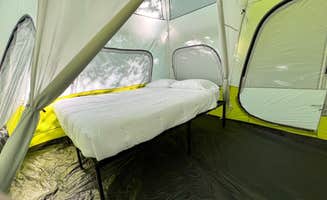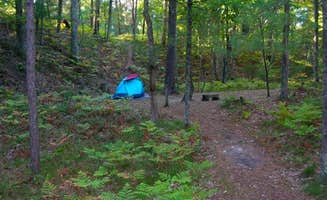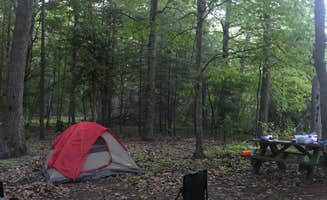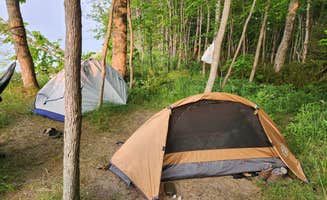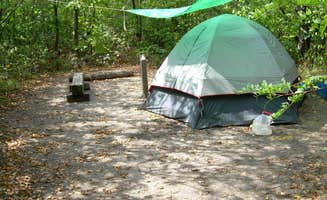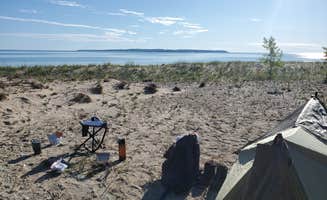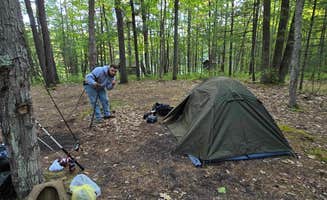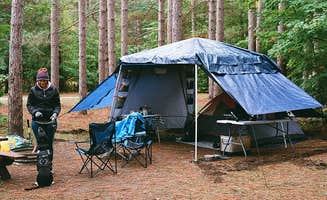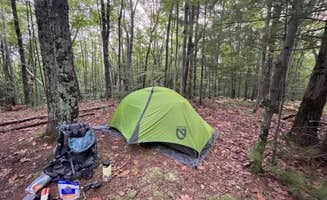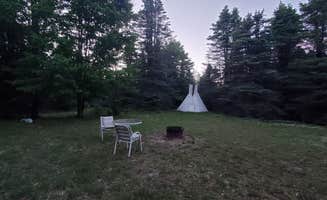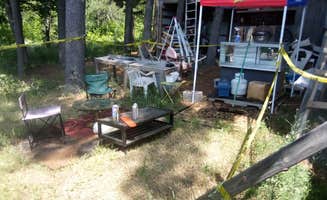Tent campsites near Maple City, Michigan range from mainland backcountry sites to boat-accessible island locations. The region sits along Lake Michigan's northeastern shoreline at approximately 850 feet elevation, with summer temperatures averaging 75-80°F during peak camping season. Most primitive campsites require campers to filter water from nearby lakes or carry their own supplies.
What to do
Explore historic ruins: North Manitou Island contains numerous abandoned structures from former settlements. "You can explore miles of trails across the islands, with opportunities to visit historical sites including lighthouses, shipwrecks, and abandoned homesteads," notes one visitor to North Manitou Island Backcountry Campsites. Another camper adds, "Your views are endless opportunities of woods, old farm fields, or possibly an settlers orchard with remains of one of the farms throughout the island."
Fish inland waters: The Sand Lakes Quiet Area offers exceptional freshwater fishing opportunities. One camper at Sand Lakes Quiet Area Backcountry Campsites reports, "Literally, some of the best fishing I have ever done. We caught so many bass we lost count. Well gave up counting. Like every other cast." These inland lakes provide alternatives to Lake Michigan fishing.
Take a ferry adventure: Most island camping requires ferry transportation from mainland points. "A 40 minute ride across to North Manitou island with views of the South Island" starts your adventure, according to one camper. Plan extra time as "the ferry is unable to reach the island in dangerous weather conditions," requiring contingency provisions.
What campers like
Privacy between sites: Many campsites offer significant separation from other campers. At the Village Campground, "The sites are isolated and well off the trail," which creates genuine seclusion. Similarly, on South Manitou, a visitor noted, "This was such a great trip. We were able to come over on a ferry, which took about an hour and then hike in after a trailer dropped us off."
Crystal clear swimming: The water clarity attracts swimmers throughout the warmer months. At Power Island County Park Primitive Campsites, campers enjoy "access to the crystal clear, turquoise lake." One visitor describes, "We kayaked with all our gear!! If you do this, Early morning! Past 2pm forget about it.. The water is visible up to 10' maybe more.. Beautiful Caribbean blue waters."
Community fire areas: Several campgrounds feature shared fire rings that create social opportunities. "There are community fire rings which led to a fun final night on the island passing some of my flasks around with fellow hikers," recalls a visitor to Village Campground. At Bay Campground, "Campsites feel secluded and each has a fire pit."
What you should know
Wildlife encounters: Island camping means sharing space with local wildlife. "At night your possibilities of hearing coyotes in the distance are good. By day you can see animals ranging from chipmunks to one of the many whitetail deer that roam the island," reports a North Manitou visitor. Others warn about "chipmunks chewing on personal items left unattended.
Insect preparation: Mosquitoes and ticks are prevalent, particularly in early summer. "Mid July was very buggy," notes a visitor to Popple Campground — Sleeping Bear Dunes National Lakeshore. Multiple reviews emphasize bringing insect repellent, with one camper stating simply, "Don't forget the bug spray."
Water logistics: Access to drinking water varies significantly between locations. "Water is about a mile out so that is a hike. After I bought water pills, so I will be more prepared next time. Friends had filter bags so that was ok," explains one camper. Many visitors recommend bringing filtration systems to treat lake water rather than relying on limited potable sources.
Tips for camping with families
Choose accessible locations: For families with young children, some campgrounds offer easier access. "The Bay Campground is located the closest to the docks about a 1/2 mile walk with your gear," making it more manageable for families. Another visitor noted, "I'd recommend the Bay for people who want a more leisurely experience."
Pack extra provisions: Weather conditions can extend stays unexpectedly. One Weather Station Campground — Sleeping Bear Dunes National Lakeshore visitor advises, "In addition to a water filter and a first aid kit, bringing extra food with you is also a must. The ferry is unable to reach the island in dangerous weather conditions."
Consider mainland alternatives: For less logistically complex family camping, Sand Lakes Quiet Area offers drive-in access to tent sites. "We ended up googling it on Google maps because the location on here was off and that got us closer. You park in this small lot with a yellow gate that is in-front of the trail and then walk down for about 10 min until you see a smaller trail to left follow that down and you will see the campsites!"
Tips for RVers
Limit to mainland options: Islands and most backcountry sites cannot accommodate RVs or trailers. The tent-focused camping infrastructure means RVers should stick to established mainland campgrounds near Maple City rather than attempting to access primitive sites.
Consider day trips: RVers can park at mainland locations and take day trips to the islands. "South Manitou Island is part of the Sleeping Bear Dunes National Lake shore" and accessible for day visits via ferry, allowing RV campers to experience the islands without overnight tent camping.


